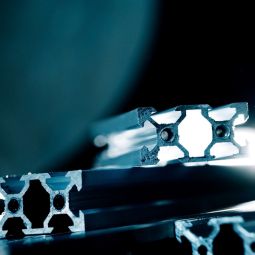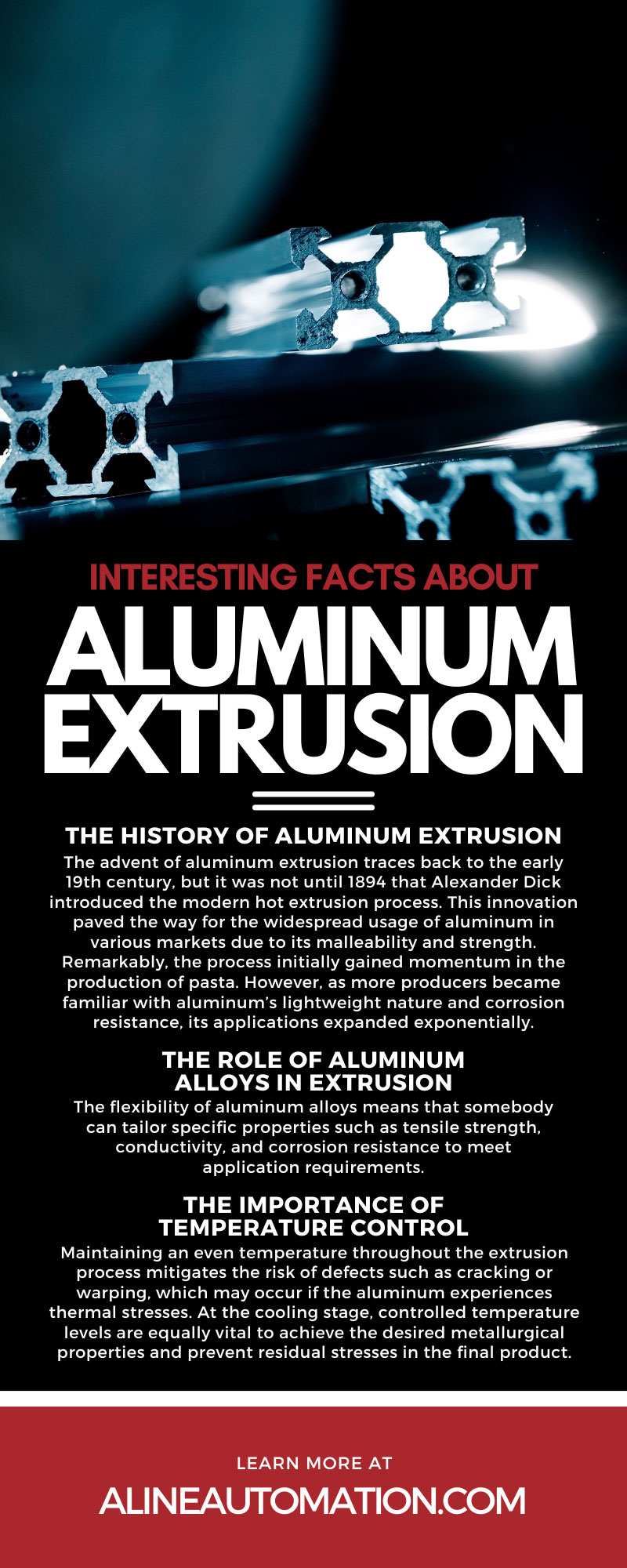
Aluminum extrusion is a fascinating process that transforms aluminum alloy into objects with a definitive cross-sectional profile for various uses. This versatile method allows for the creation of complex shapes with excellent structural integrity while maintaining the inherent properties of aluminum.
As a material that figures prominently in various industries —from automotive to construction and aerospace—understanding the intricacies of aluminum extrusion can reveal insights into its significance and applications. These nine interesting facts about aluminum extrusion will help you appreciate its value even more.
The advent of aluminum extrusion traces back to the early 19th century, but it was not until 1894 that Alexander Dick introduced the modern hot extrusion process. This innovation paved the way for the widespread usage of aluminum in various markets due to its malleability and strength. Remarkably, the process initially gained momentum in the production of pasta. However, as more producers became familiar with aluminum’s lightweight nature and corrosion resistance, its applications expanded exponentially.
Producing aircraft during World War I was among the first major uses of aluminum, as engineers sought materials that would reduce weight and improve efficiency. Following the war, the extrusion process evolved, and its applications stretched to the construction of architectural frameworks and automotive components.
Aluminum extrusion is a multi-step process that begins with designing and creating a die, which shapes the aluminum profile. Next, experts heat a billet of aluminum to a pliable temperature and force it through the die using a hydraulic press. As the aluminum emerges from the die, it takes on the desired cross-sectional shape.
They then cool the extruded aluminum, often with fans or water, to stabilize the metal. Then, pieces undergo a straightening process to correct any distortions. Finally, professionals are able to cut the lengths of extruded aluminum to size. The aluminum pieces may undergo further treatments such as aging, which hardens the aluminum to enhance its mechanical properties, or anodizing, which increases corrosion resistance and allows for color application.
Aluminum alloys play a crucial role in the extrusion process, as their varied compositions lend distinct characteristics to the finished product. The most commonly used alloy in aluminum extrusion is the 6000 series, which includes elements such as silicon and magnesium.
This highly workable and relatively strong series makes it suitable for various applications, from structural components to consumer goods. The flexibility of aluminum alloys means that somebody can tailor specific properties such as tensile strength, conductivity, and corrosion resistance to meet application requirements.
Temperature control during the aluminum extrusion is critical for producing high-quality, consistent profiles. Precise temperature regulation ensures that the aluminum billet reaches the optimal plasticity required for extrusion, facilitating the metal’s smooth passage through the die.
Maintaining an even temperature throughout the extrusion process mitigates the risk of defects such as cracking or warping, which may occur if the aluminum experiences thermal stresses. At the cooling stage, controlled temperature levels are equally vital to achieve the desired metallurgical properties and prevent residual stresses in the final product.
One of aluminum extrusion’s most remarkable qualities is its customization capacity. This flexibility is a game-changer for industries that require tailor-made profiles to meet specific engineering and design specifications. By creating custom dies, manufacturers can produce unique extruded shapes that are precise and repeatable across large production runs. This ability to customize extends to the alloys themselves; by adjusting the composition, companies can engineer the material properties to suit the environmental and mechanical demands of different applications.
One of the most compelling attributes of extruded aluminum is its impressive strength-to-weight ratio. This characteristic is particularly resonant in industries where reducing weight is beneficial but strength is still necessary, such as aerospace, automotive, and transportation.
In extrusion, you can preserve the structural integrity of aluminum, even when formed into complex, thin-walled profiles. This step leads to components that support significant loads while reducing overall mass. For example, using aluminum extrusion in vehicle frames contributes to lower fuel consumption and increased payload capacity. In aerospace applications, the strength-to-weight advantage translates into enhanced aircraft performance and better fuel efficiency.
Aluminum extrusions can undergo various surface treatments and finishing techniques to improve aesthetics and functionality. Common finishes include powder coating, which provides a durable and colorful finish, and anodizing, which enhances corrosion resistance and surface hardness. Additionally, you can paint extrusions or electroplate them to achieve the desired visual appeal or protective qualities. These finishes extend the lifespan of aluminum products and offer professionals a broader palette from which to work, enabling the creation of components that meet both technical and visual specifications.
One of the most significant advantages of aluminum is its recyclability. We can recycle aluminum indefinitely without losing quality, making it a highly sustainable material choice. The energy required to recycle aluminum is merely a percentage of that needed for primary production, which implies considerable energy savings and a reduction in carbon footprint. This property has profound implications for environmental conservation, as recycled aluminum plays a crucial role in sustainable building practices, eco-friendly packaging solutions, and energy-efficient transportation initiatives. The endless recyclability of aluminum positions it as a material vital for fostering a more sustainable future.
Innovative uses of aluminum extrusions are shaping the future of modern industries. For instance, extruded aluminum frames robustly secure solar panels in solar energy systems, facilitating cleaner energy solutions with longevity. Similarly, tech industries use aluminum extrusion for heat sinks in electronics due to its excellent thermal conductivity. In contemporary architecture, aluminum extrusions meet complex design requirements while supporting sustainable construction. From the minute frameworks of intricate gadgets to the grand facades of eco-friendly skyscrapers, aluminum extrusion proves its versatility and indispensability in pushing the boundaries of innovation across various sectors.
These aluminum extrusion facts demonstrate the incredible potential of this process and its instrumental role in shaping our lives. From historical roots to modern-day applications, aluminum extrusion has come a long way, and its versatility and sustainability continue to make it an indispensable material for countless industries. So next time you see a sleek aluminum frame or a lightweight aircraft wing—remember these nine interesting facts about aluminum extrusion and appreciate the ingenuity of creating such versatile and essential products.
If you’re looking for Bosch aluminum extrusions for your project, A-Line Automation offers a wide selection of high-quality extruded aluminum profiles in various sizes and shapes. Contact us today to learn more about our products and services.
